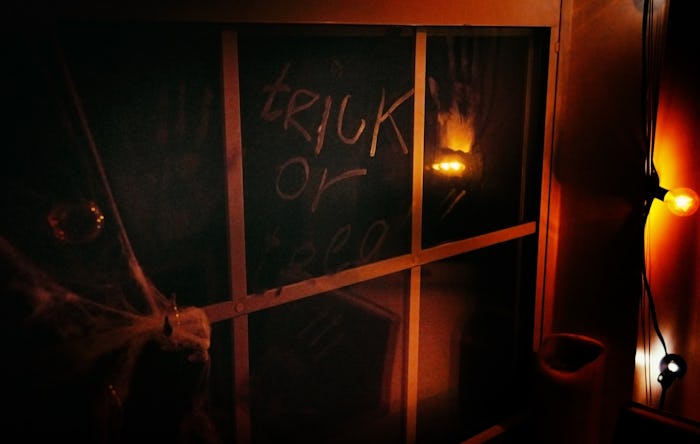Life

Here's What Doctors Want You To Know About Visiting A Haunted House This Year
So much about the Halloween season is cause for celebration, and activities like visiting spooky mansions filled with ghouls and goblins are downright scream-worthy. But is it safe to go to a haunted house this year? Unfortunately there are some risks, and doctors have some thoughts about haunted houses.
"As a physician, I can’t say I am in favor of kids or adults doing this right now," Dr. Niket Sonpal, a New York-based internist and gastroenterologist, tells Romper. "It’s not an 'essential,' and I feel it’s something people can live without until the pandemic is over."
In their guidelines for holiday activities during the ongoing COVID-19 pandemic, The Centers for Disease Control and Prevention (CDC) mentions several scenarios for visiting haunted houses, but lists traditional indoor haunted house visits in the high-risk category.
"Haunted houses are usually closed-in spaces, built around being close enough to other people that it's easy to surprise them," Dr. Stephanie Hemm with LifeBridge Health Pediatrics at Loch Raven tells Romper. "Then there is usually screaming by an actor to scare guests who may also scream. Close proximity inside and forceful breathing is exactly how we know COVID can be easily spread."
Additionally, the darkness of a haunted house, the potential of poor ventilation, and an inability to social distance inside are also concerns to consider. "When people get 'spooked,' they have a tendency to jump or huddle together," Sonpal says. "None of this is good for social distancing."
Although it is considered high-risk, if you do decide to visit your favorite indoor haunted house this year, Sonpal tells Romper that visitors should remain vigilant when it comes to following health and safety precautions. "If you absolutely must go, evaluate the crowd before you walk in," he says. "Gatherings with attendees who are not adhering to social distancing by staying at least 6 feet apart, mask-wearing, and other prevention behaviors pose more risk than gatherings with attendees who are engaging in these cautious behaviors. If masks are not required to enter, do not go."
Additionally, you can protect yourself by not touching things inside of the haunted house, making sure that any 3D glasses or props you might handle are new and in a sealed package, wearing a face covering through the duration of your visit, and washing or sanitizing your hands. Knowing what's safe and what could put your family at risk for contracting coronavirus is imperative when navigating new Halloween norms this year.
I’m not personally a fan of having the ever-living daylights scared out of me. People dressed up like zombies popping out from behind crumbling walls and chasing me with chainsaws just isn’t my idea of fun. But, if you happen to enjoy the thrill of masked individuals emerging from a swath of spiderwebs screaming at you, there are other ways you can engage in haunted house-like activities this year without going to an indoor event.
"The only haunted house events this year that have any potential to be safe are ones held outside. Think of a 'haunted trail' type situation," Hemm explains. "Each family or other 'safe' group is in a separate, personal car and they drive through a park-like setting. That would be much like the holiday light displays in December."
The CDC website states, "Going to an open-air, one-way, walk-through haunted forest where appropriate mask use is enforced, and people can remain more than 6 feet apart," is considered to be a moderate risk. However, because the novel coronavirus is spread primarily through the transmission of respiratory droplets, the CDC does note that "greater distancing is advised," if there will be any screaming involved. Which, with most haunted experiences, there likely will be.
Experts:
Dr. Niket Sonpal, New York-based internist, gastroenterologist, and adjunct professor at Touro College
Dr. Stephanie Hemm, LifeBridge Health Pediatrics at Loch Raven
This article was originally published on